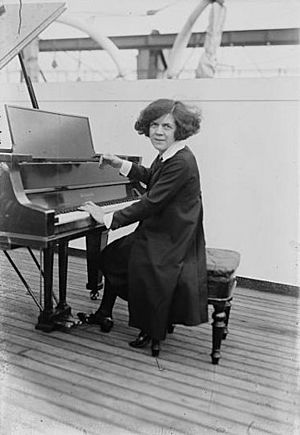Ethel Leginska facts for kids
Ethel Liggins (born April 13, 1886 – died February 26, 1970) was a talented British musician. She was a pianist, composer, conductor, and music teacher.
Ethel was a student of famous teachers like Theodor Leschetizky for piano, and Rubin Goldmark and Ernest Bloch for composing. She also learned conducting from Eugene Goossens. She taught many students, including Gavin Williamson and Daniel Pollack. Ethel Leginska was a true pioneer, being one of the first women to conduct many of the world's top orchestras.
Contents
Ethel Leginska's Amazing Life Story
Ethel Liggins was born in Hull, England. A kind supporter named Mary Emma Wilson helped her study piano at the Hoch Conservatory in Frankfurt. She also studied in Vienna with the famous pianist Theodor Leschetizky.
In 1905, she toured Australia. From 1906, she started using the stage name Ethel Leginska. This name sounded Polish, and at that time, Polish musicians were very popular. This helped her career a lot! When she first performed in the United States, people called her "The Paderewski of women pianists."
In 1907, Leginska married composer Emerson Whithorne. They sometimes performed together. They had a son, Cedric, in 1908. The couple later separated in 1910 and divorced in 1916. After this, Leginska spoke out even more about the need for more opportunities for women in music. She believed women with careers should not have to sacrifice their dreams.
Becoming a Star in America
Ethel Leginska became very popular in the U.S. after her first official performance in New York in 1913. Her shows were carefully planned with special lighting. She also had a unique style, often wearing menswear, which her young fans loved. People were always amazed by her skill, especially since she looked so young!
In 1923, Leginska went to London to learn how to conduct orchestras. She also studied with Robert Heger in Munich. Soon, she was guest conducting major orchestras in cities like Munich, Paris, London, and Berlin. Being a woman conductor was new and exciting, which helped her get noticed. She even conducted her own orchestral music.
In 1925, she made her conducting debut in the United States with the New York Symphony Orchestra at Carnegie Hall. She then performed with other orchestras. In 1926, she decided to stop performing as a pianist. From then on, she focused on conducting, composing, and teaching music.
Leading Orchestras and Teaching
Even though she didn't compose a lot of music, Ethel Leginska was a great organizer. She started the Boston Philharmonic Orchestra and conducted it from 1926 to 1927. She also led the Boston Woman's Symphony Orchestra and took them on two big tours. She even founded the National Women's Symphony Orchestra in New York in 1932.
In the late 1930s, she moved to Los Angeles. There, she opened a piano studio and became a respected teacher. In 1943, she started a concert series called New Ventures in Music. This series helped her talented students perform for the public. In 1957, she conducted her first opera, The Rose and the Ring, which she had written in 1932.
Ethel Leginska passed away in Los Angeles in 1970 at the age of 83.
Ethel Leginska as a Teacher
After 1935, Leginska focused more on teaching. She taught in London and Paris before settling in Los Angeles in 1939. She became a very well-known piano teacher. Some of her students included Gavin Williamson, James Henry Fields, Daniel Pollack, and Bruce Sutherland.
Ethel Leginska believed in playing the piano with a relaxed body. She once said, "I believe in absolute freedom in all parts of the arm, shoulder to fingertips. Stiffness seems to me the worst thing when playing the piano."
In 1943, Leginska and her manager, Mary V. Holloway, started the New Ventures in Music concert series. The goal was to show off her talented young students. These concerts were a huge success! Young musicians performed all of Bach's Well-Tempered Clavier and all of Beethoven's sonatas. Later concerts featured all the works of Chopin and Schumann. Famous musicians like Bruno Walter and Arthur Rubinstein praised the series. When students performed piano concertos, Leginska even hired professional orchestra members to form her own "Leginska Little Symphony," which she conducted herself.
Ethel Leginska as a Composer
Besides her performing career, Leginska also studied composing. She took lessons with Rubin Goldmark and Ernest Bloch. Soon, she began writing her own pieces for piano and small groups of instruments.
One of her first public works was a string quartet. It was inspired by poems from Tagore and won an award! She also wrote a symphonic poem called Beyond the Fields We Know. Her piece The Gargoyles of Notre Dame was inspired by Victor Hugo's novel The Hunchback of Notre Dame. She also wrote an orchestral suite called Quatre sujets barbares, inspired by the artist Paul Gauguin.
In 1957, Leginska conducted the first performance of her opera The Rose and the Ring in Los Angeles. It was based on a story by William Makepeace Thackeray and had been written 25 years earlier.
Ethel Leginska's Musical Works
Ethel Leginska didn't write a huge number of pieces, but her work includes piano music, songs, orchestral pieces, and three operas. Many of her works are still not published.
Songs (Melodies)
Orchestral Music
|
Chamber Music
Piano Music
Operas
|



